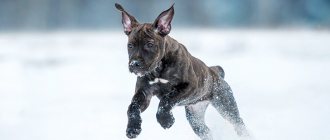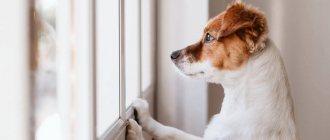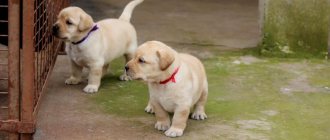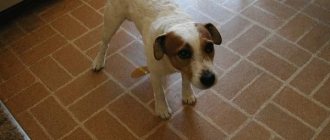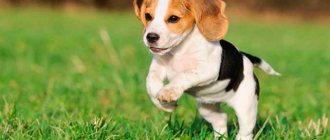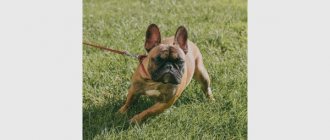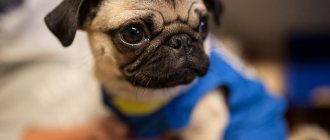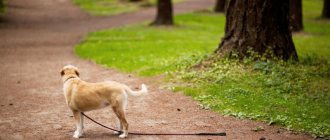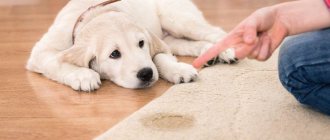When you have a four-legged friend in your home, you need to train him to walk. This is a very important and at the same time difficult mission that almost anyone can cope with. How to teach a dog to go to the toilet not in the apartment, but only on the street? Enter the concept of “mode”. At the same time, feed the animal and take it for walks, this will help accustom it to order. The pet will know that at a certain time he will definitely be taken out for a walk and will learn to endure. In addition, any training or development of a useful habit is accompanied by encouragement. The dog should be rewarded for every “effective” walk.
The controversial issue is to punish your pet for toileting at home? It is strictly prohibited; not all animals understand why they were punished when trying to train them. Apart from fear, this does not lead to anything good. Here you need to be patient, don’t raise your voice, follow the schedule and everything will work out.
No time to train your dog to walk?
A dog walker from the Guldog service will help you accustom your pet to regular walks.
Order service
Where to begin?
Until the puppy has received all its vaccinations, you cannot walk it outside. Therefore, as soon as the baby appears in the house, he should be taught to go to the tray, to a special absorbent diaper, or, in extreme cases, to a newspaper. And so that he is not tempted to do his “business” anywhere, you must first remove all carpets from the floor, since the dog prefers to relieve itself on a soft surface.
The main thing is to remember that the puppy does not shit where he lives. It’s so inherent in instincts by nature. Therefore, the proposal of some dog breeders to cover the entire apartment with newspapers is far from the best way out of the situation.
The puppy's toilet should be in one place. And as soon as it starts to spin, it should be immediately moved there. Very little time will pass and the baby will understand what his owners require of him. The main thing is that the diaper or tray is removed on time.
However, there are situations when the puppy starts playing and does not have time to reach the right place. In this case, he should not be scolded or punished. He is still too small to require the skills and abilities of an adult dog. Otherwise, he will simply hide and make a puddle wherever he has to.
Suitable age to start walking
Approaches to their names should also be rewarded.
Veterinarians strongly recommend not walking puppies until all vaccinations have been completed and quarantine is over. Only after this is it possible to start walking. Since this concerns the health of the pet, it is worth listening to the advice.
On your walk you should take with you:
- water;
- treats;
- diaper.
Regarding water, everything is clear. Treats may be needed to calm down and begin to learn the simplest commands - “come to me” and “near”. They begin to study them from the age of 3 months, but it is advisable to accustom them and start voicing them earlier. It is worth rewarding with a treat simply for the fact that the baby came to the name or even just paid attention to the owner.
A diaper can help train your dog to relieve itself outside. As soon as the baby begins to demonstrate characteristic behavior, it should be laid directly on the ground. If the baby has already gone to the diaper at home, then he will go to it outside. Gradually, he himself will understand that he should relieve himself outside the home.
Features of winter walking
While the pet is still small, long walks in winter are contraindicated for him. It is also worth considering the breed. If even at a small age the dog is large in size and has thick fur, you can not worry and walk even at low temperatures, but still not for long. Also, you should not keep your baby in an enclosure, even if he will live there in adulthood.
Representatives of small and smooth-haired breeds should only be taken out for short periods of time at low temperatures. This applies to small varieties of terriers, chihuahuas and the like. Winter is not the time for them to play outside, but summer is the most suitable time.
Important! Small puppies must be dressed in sub-zero temperatures outside. While their body is not yet strong, they are very susceptible to colds.
Babies need to be dressed for winter walks
How to train a puppy to ask to go outside?
As soon as all vaccinations are completed and the quarantine period is over, you can start walking the puppy and teach him to go outside when he needs to. But do not delude yourself that the dog will immediately begin to defecate only during a walk. We'll have to be patient. The adjustment period will take from several weeks to several months, depending on the breed and temperament of the baby. However, the correct behavior tactics of the dog owner will help bring this moment somewhat closer. The basic rules are as follows:
- As soon as the puppy wakes up, immediately take him outside. After eating, take it out again. At first, you can take a diaper with you so that he can quickly find his bearings and not be distracted by unusual smells;
- It is recommended to walk a small pet 5–6 times a day, sticking to approximately the same time;
- after each successful defecation on the street, the puppy must be praised and rewarded with a treat;
- After the dog has done its “business,” you can play with it or allow it to communicate with other relatives, making it clear that all pleasures are possible only after the toilet.
When the puppy is 6–8 months old, the number of walks can be reduced to 4 per day. At this age, dogs already begin to ask to go outside to relieve themselves. At this stage, it is important to adhere to a clear walking schedule. Then the dog will get used to going to the toilet outside at a certain time and will not be distracted by asking for walks at inappropriate times.
A detailed plan for toilet training a dog
Training a dog to toilet outside is a step-by-step process. Fortunately, most dogs try to have a designated place to relieve themselves and try not to shit in the places where they eat and sleep, so dogs learn well using a standard plan. First, make sure that you control your pet, that is, he is always in one of three positions:
- on the street where you are watching him;
- in an apartment/house under your supervision;
- in a confined, relatively small space, such as a cage, playpen or small room.
Depending on the situation, you must take certain actions. Let's consider each case separately.
You are walking your dog on the street.
While spending time together with your pet on the street, you keep an eye on him and, accordingly, know whether he has done his business before returning home. You can reward your dog for going to the toilet outside so that he understands that such actions on his part are correct.
Prepare treats for your pet in advance; they can be hidden in your jacket pocket, trousers pocket or bag. Make sure the treats are really good - to the dog's taste. Just as people would rather receive a piece of cake or a chocolate bar as a reward than broccoli, dogs have their own preferences. For many animals, pieces of low-fat cheese or meat are an excellent reward. Special dry, flavored treats are also very effective - by human standards, they can be compared to cookies. Regular dry food granules, which the dog already receives every day, may not be in great demand, like carrots for children.
Find a specific place around the house where you would like your dog to go to the toilet. If at first you bring the puppy to the same corner, then over time he will come running there himself. When you arrive at the chosen location, stop and wait until the dog begins to relieve itself. It should be fairly flat, but at the same time a secluded space.
The main thing is not to look at your pet closely while he sniffs the ground and “takes aim.” The animal may mistake your direct gaze for your desire to communicate or play, so it will not get down to business. If eye contact has already taken place, and the dog is interested in you, or the alluring smell from your pocket, just look somewhere to the side, crossing your arms over your chest. The pet will quickly lose interest in you and return to exploring the toilet area.
Wait until the puppy relieves itself. Once he's finished, praise him and give him the treat you had in store. While the dog is eating, you can stroke him, telling him that he’s doing well and calling him a good dog.
Positive food reinforcement is an important part of a dog's toilet training plan, but not all owners know about it. Many people give their pet a tasty reward when it has already emptied and runs back to them. But look at it from the puppy's point of view: in his mind, he received a reward for approaching his owner. The reward must be received immediately, which means that at first you will have to constantly be next to the dog on the street, without leaving its side. In some cases, it is the moment of giving out the treat that determines whether the puppy will become accustomed to using the toilet outside.
Kind words spoken with an enthusiastic intonation also make puppies very happy, but when you combine praise with food encouragement, they still learn faster. Some owners don't want to use treats, but it's a really effective tool, so why not use it? Judge for yourself: it’s one thing if at work they tell you: “You’re great, thank you!”, and quite another thing – “You’re great, thank you, keep your bonus!” Over time, when the puppy begins to consistently go outside to relieve itself, you will begin to give treats every other time, then even less often, and when the process becomes automatic, you will be able to refuse them.
The puppy is at home under supervision.
In an apartment or house you must constantly supervise the dog. To do this, you don’t need to look at your pet point-blank without taking your eyes away, otherwise he might get scared. It’s enough to glance at him with half an eye while going about your business, for example, making tea or listening to an audiobook. A puppy in a new home can be compared to a baby who has just learned to walk. It only takes a second for a child to disappear from sight. Likewise, a puppy, previously quiet and calm, can suddenly think about something of his own and run to make puddles. To make it easier to keep track of it, you can close the doors or place partitions in the openings, limiting the space for maneuvers to 1-2 rooms. If your dog is small or medium-sized, then you can fasten it to yourself by tying a leash around its waist, then it will not be able to sneak away while you are not looking.
If you do not look after your dog well, constantly missing the moment when it goes to the toilet, especially at the early stage of training to go outside, then training may be seriously delayed or completely useless. It is the owner's responsibility to take the dog out to relieve itself on time. Don't forget, initially the puppy does not realize that it matters a lot to people where he goes to the toilet.
The dog is left to its own devices in a cage or room.
In those moments when you are busy with your own affairs and cannot fully look after the puppy, you must leave it in a limited area. A playpen, cage or small room ready for testing by the dog is suitable for this. If the space is small, then the likelihood that the puppy will shit there will be less, since the baby will instinctively try not to dirty the area where he sleeps or eats. In addition, the limited space will not allow the dog to relieve itself in any other places in the apartment, which will avoid the development of bad habits, for example, shitting in the kitchen or marking in the hallway.
The presence of a dog crate causes conflicting feelings among owners, but it should be said that many puppies are comfortable sleeping in confined spaces that resemble a den if they are accustomed to this from childhood. It is advisable to place the cage in the bedroom so that at night the pet feels that you are next to him. If your ward is one of the dogs that cannot tolerate a crate, or you simply would not like to use it, then leave the puppy in a small room or kitchen, isolating his habitat with a partition. You can also use a playpen in which your pet will have a bowl of water, a bed and various toys. It is worth keeping in mind that the playpen is only suitable for small breeds of dogs, since medium and large animals can turn it over and get out.
Make sure in advance that in the area allocated for the dog there is a floor covering that is easy to clean, then the mistakes that occur at first in almost all puppies will not upset you too much. Whatever you use - a crate, playpen or bed - it should be cozy and comfortable for the dog, that is, it is too cold or hot, and the size allows the animal to sleep comfortably. Make sure that the dog is not near the window, because he may become overly interested in what is happening on the street and become overly worried, or, conversely, become frustrated.
In order for the puppy to get used to the crate and perceive it as his safe corner, and not as a trap and a form of punishment, proceed according to the following scheme.
Step 1. Stock up on treats and throw them inside the crate so that the puppy will come in and eat the bait. If he begins to suspect something and is afraid to come in, place a treat on the threshold. Gradually you will be able to throw pieces of food further and further. The dog should be free to enter and leave the crate whenever it wants. This way, climbing in will begin to be associated with play and reward. Do this exercise 3-5 times, repeat several times a day.
Step 2. As soon as the puppy gets comfortable and runs freely into the crate, wagging his tail, it’s time to close the door behind him. Start with 2-3 seconds. After a couple of days, put in a treat, close the door, then feed your pet through the bars and finally let him out of the cage.
Step 3: Now it's time to leave the puppy in the crate for a longer period of time. To do this, you can use a Kong-type toy. It is a ball with a hole for food. The dog will chew the toy and periodically take out pieces of food from it, which will definitely interest it more than the cage door. If Kong is not available, you can use other objects that your pet likes and usually distract him. When the puppy is busy playing or getting treats, go to another place for half a minute or a minute. Then open the crate door and call your puppy outside. If you practice this regularly, increasing the time intervals, the dog will learn to be calm in the crate.
To make it easier for the puppy to get used to the sleeping place, you can put a towel there, on which he slept at the breeder with his mother, brothers and sisters, or put your own T-shirt. As a last resort, a small soft blanket or fluffy toy will do.
It is advisable to place your pet in a crate when you see that he is starting to fall asleep, then it will be easier to develop the habit of sleeping in a certain place. Usually dogs want to sleep after they have run around and played enough. They nod off or lie down on the floor as if an internal switch has gone off. If you missed the moment and the baby managed to fall asleep somewhere in the apartment, carefully pick him up in your arms and put him on a sleeping place. Do this as quietly as you can.
Now you can use the crate both at night and during the day - in those moments when you cannot look after the dog at home and do not walk with it on the street. As for the location of the cage, it is preferable that it be in your bedroom. At night, your pet will feel your presence nearby, smell you, hear your breathing, which will calm him down. The puppy may have never spent the night alone with the breeder, so your proximity will make adaptation faster. During the day, the cage can be moved to another part of the apartment, if it is more convenient. The only thing is that it is undesirable to place it on the aisle, where the dog can often be disturbed by household members passing back and forth.
What to do if the puppy relieves itself in the crate? Don’t worry, clean up so that there is no unpleasant smell left and analyze what caused the failure. Was the dog locked up too long? Did she go to the toilet before you put her in the crate? Maybe her diet or drinking regimen has changed? Do you walk your puppy often enough? Are there medical problems that prevent you from maintaining sufficient time intervals?
Even if you don’t understand why the confusion occurred, don’t be upset. Failures happen to everyone. Any dog can make mistakes several times during the training process. If the situation looks like the puppy is specifically relieving himself in the crate, move him to another fenced area or small room.
There are animals that accept the sleeping place prepared for them immediately, while others are capricious or afraid when their owners are about to put them to bed. This is worth dwelling on in more detail, since it is extremely important to distinguish whether the puppy is whining or barking because he knows that in this way he will get out of the crate, or he is signaling that it is time for him to go outside, and his needs cannot be ignored. Most often, you can ignore the puppy's dissatisfaction when you have just put him in a crate, and he has recently relieved himself. Many pets go to bed within a few minutes and immediately fall asleep. But if a quiet and well-balanced baby suddenly starts whining in the middle of the night, get up and take him outside to find out if he needs to go to the toilet. See how he behaves on subsequent nights. If you understand that the puppy does not need to relieve himself, and he wakes you up only to play, then ignore his calls in the future. If he gets into the habit of going to the toilet at night, then wait more and more time each time before going out with him. It is especially worth listening to dogs that start crying at 5-6 in the morning - the likelihood that they need to go to the toilet is highest. Try to let your pet out of the cage at the moment when he calms down and does not bark, so that the dog does not think that he can achieve what he wants just by raising his voice. Wait for a pause or make some kind of harmless sound yourself that will confuse your pet and make you quiet down, with your ears pricked up.
Puppies usually love their crates and get used to them quickly. This place can be compared to a person's bedroom. But there are also individuals for whom this option is not suitable. When they get into a cage, they breathe heavily, drool, bark angrily and do not calm down. These puppies will do better staying in a small room. After all, they didn't read the article about how they should love lair-like spaces. But this category of pets is in the minority, so don’t give up crate training your dog if it’s just fussing around there for a couple of minutes. You need to take the puppy outside immediately after opening the cage - otherwise why did he endure it?
Gradually expand your dog's freedom of movement around the house. Spend time with your pet in different rooms, leaving your scent in them, train them there, or just play.
Other situations
They simply don't exist! In the process of learning to go outside to relieve yourself, the puppy should always be in one of 3 positions: with you on a walk, under supervision at home, or alone in a limited safe space.
Don't make exceptions. If you don't make mistakes, toilet training will be effective and won't take much time. Literally a month of effort - and you will get a comfortable life with a clean dog.
Why do problems arise?
There are situations when a well-mannered dog begins to relieve itself in the house again. Despite the fact that in this case the desire to scold and punish her overwhelms the owner, this should not be done. The only way out of this situation is to try to understand the reasons for the pet’s behavior. There may be several of them:
- health problems;
- jealousy of the owner due to the appearance of another animal or child in the house;
- lack of attention;
- loss of the owner's authority.
First of all, you need to show your dog to a veterinarian to rule out possible diseases. If everything is in order with health, you will have to analyze other possible causes and begin to accustom the animal to walks again, like a puppy.
But what should you do if, even after a walk, your pet still pees at home? Then a few tips will come in handy:
- exclude all diuretic products from the animal’s menu;
- on a walk, find a friend for your pet who would become not only a playmate, but also an example for the necessary actions;
- always take water for a walk - after drinking it after active games, the dog can relieve itself on the street;
- increase the time the animal is walked - the pet will not be able to tolerate it for long and will definitely go to the toilet before returning home.
The main thing is to never yell at the dog or poke its nose into a puddle. She may misinterpret such actions, concluding that she should not shit in front of the owner. Then the dog will continue to do things in his own way, but in his absence.
Nuances of training
We have discussed the main points on how to teach a dog of any age to manage its natural needs. But any process can be ruined and no result achieved if you do not follow some rules:
- give time to an animal of any age, be especially patient;
- during the walk, try to go to quieter places so that the dog can feel calm;
- set a routine, trying to walk your pet at approximately equal intervals;
- You cannot use physical punishment on the puppy, poke your nose into puddles, or scream loudly;
- you will only achieve that the baby will be afraid of you;
- Punishment can be applied to an adult dog. For example, lightly slap the withers;
- If you decide to punish, do not do it with your hand. You stroke your pet with your hand and give him a treat. This means that it should be associated only with good things. You can take a newspaper, a leash;
- do not intentionally cause pain to the animal, especially for training purposes;
- If after time the problem with the toilet remains, take the dog to the veterinarian. Perhaps she has problems with her kidneys or genitourinary system;
- come up with a daily approximate route so that the dog has “his” places. It so happens that after going your usual way, you will take a walk and the animal will relieve itself.
Taking care of your pet's health: the hidden dangers of walking
Walking is not only a lot of fun and positivity for the puppy, but also the risk of becoming infected with worms or external parasites. Therefore, preventive deworming should become the norm for your pet. A good solution for dogs with a short muzzle, as well as for capricious and biting pets who cannot easily give medicine by mouth, is the “Spot-on” form - drops on the withers. These drugs include Dironet® Spot-On for puppies. This is a medicine for external use in the form of drops. For treatment, it is used once, applied to the dry skin of the pet. For prevention, Dironet® Spot-On is used once a quarter or once every six months, depending on the dog’s lifestyle. This drug is suitable for puppies from 2 months of age.
First walk
For further full development and formation of a healthy psyche, it is very important to form a positive impression of the puppy from the walk. If the baby is scared, this may leave a negative impression in his memory, which will lead to a number of further problems. Therefore, it is so important to understand not only how to accustom a puppy to the street, but also how to do it correctly.
It is necessary to introduce your little friend to the outside world and his relatives very carefully. These are his first steps and the beginning of socialization, which plays a very important role in his future life. It is necessary to gradually accustom a dog to walking on the street and to relieve itself on the street.
Important! You shouldn’t immediately show your baby all the surroundings and start introducing him to other dogs on his first walk. When he is on the street for the first time, the main thing is to make him feel confident next to his owner.
How to avoid unpleasant consequences
There are a number of recommendations that will help you avoid unpleasant consequences both during walking and in the future raising of the puppy. There are several of them:
- Doesn't try to show as much as possible at once.
- Encourage your baby while walking and play with him.
- Introduce him to his relatives as carefully as possible.
- Avoid places where there are crowds of people or cars.
All mistakes made during the first walk can lead to a number of unpleasant consequences. The baby may become afraid of people, cars, or even other dogs. Overcoming this fear will be difficult and you will most likely need the help of a dog handler.
One of the main tasks of the initial period of walking is socialization. This period is very important and therefore cannot be missed. Otherwise, the dog may become intimidated or, on the contrary, aggressive. Correcting this behavior in adulthood will be very problematic. Sometimes the problem cannot be solved at all and you have to live with a cowardly or unrestrained dog for the rest of your life.
Sometimes a dog handler may be needed to correct mistakes.
What not to do
When training a dog to a booth or enclosure, dog breeders should not carry out the following actions:
- Forcing your dog into a kennel, as this will only scare him. It is better to slowly, carefully find out what caused this behavior.
- Overwork, force you to repeat the “place” command. It is advisable to gradually increase the intervals of stay in the booth, and the rest of the time to give the animal freedom.
- Overindulge. Everything needs moderation.
- Punish inside the kennel, force the pet into the enclosure.
Arrangement of the booth
First, choose the material for the kennel: wood, metal, plastic. Plastic buildings are usually lighter and cheaper. They are quite easy to transport, they do not rot, do not require painting, and are easy to wash.
Wood buildings are stronger, more durable, and a better insulator than plastic, so your dog is less likely to overheat inside the kennel. But wood has one significant drawback - rotting.
In addition to plastic and wooden ones, there are also iron booths. They are durable, easy to care for, but uncomfortable and bulky.
The roof of the booth must be strong and airtight.
You should definitely consider ventilation; for this you can put the kennel on a pallet or legs.
It is better to choose polystyrene foam as room insulation. They are easy to use, lightweight, and have high thermal insulation properties. Felt is also used instead: it is durable and has good vapor permeability.
The bedding for the booth should not be too large or small. The material is also important for her. Blankets, towels, carpet, hay, straw, and newspapers often become moldy. Fleas and bedbugs will live in them.
The best bedding option is pillows filled with cedar shavings, as the oil from this tree will repel insects. However, it can cause allergies in dogs. To minimize this possibility, fill a small bag with cedar shavings and place it in the kennel to repel fleas and bedbugs.
Possible problems and their solutions
If the owner has tried everything, but the dog does not want to follow commands and does not obey, then you need to look at your behavior.
The following problems may occur:
- The owner repeated one command many times. If your pet wants to come only the fifth time, then you shouldn’t give him a treat. He will think that the order must be submitted many times, so he will not approach the first one.
- Fastening to a leash. It is prohibited to perform this action immediately after executing the order. First you need to call the animal, and after some time fasten the leash.
- Wrong intonation. Many owners cannot develop a commanding tone so that their pet will obey. Don't break down or yell at the puppy. Relationships with a dog should be built on mutual understanding. It is necessary to work on intonation so that the pet follows commands.
- You should not punish after following an order. If the animal does not approach the first time, then it is forbidden to scold it. The dog develops a misconception about the command. You should not get angry, otherwise this will lead to your pet stopping obeying.
If these mistakes are avoided, then after some time the owner will be able to walk the dog without a leash. She will listen to him, understand and love him. It is best to follow all recommendations to avoid mistakes.
Sequencing
You will need to follow certain steps to quickly teach your puppy to walk nearby without a leash.
Next steps:
- You need to keep your dog on a leash. When he is near his leg, you need to put the harness on his back and continue walking. Stop and tell your pet “near” and “sit.” As soon as he follows the command, you need to give him a treat.
- It is recommended to repeat the above steps twice and give treats every other time. The dog must learn to follow orders without treats.
- Next you will need to change the trajectory of movement. You should repeat the command, and then change direction, walk slightly and stand up. The pet must sit on command. These steps are repeated several times.
- As soon as the pet walks near the leg, it is necessary to turn without a leash, speed up or slow down. It is imperative to pronounce “Nearby”.
See also: How to show your dog that you are the leader
All orders must be spoken clearly and confidently so that the dog understands. You should not scold or shout at the puppy, as it will no longer trust its owner. The pet must turn or change the pace of movement without a leash and without commands. It is best to teach your dog to perform all actions on a leash.

